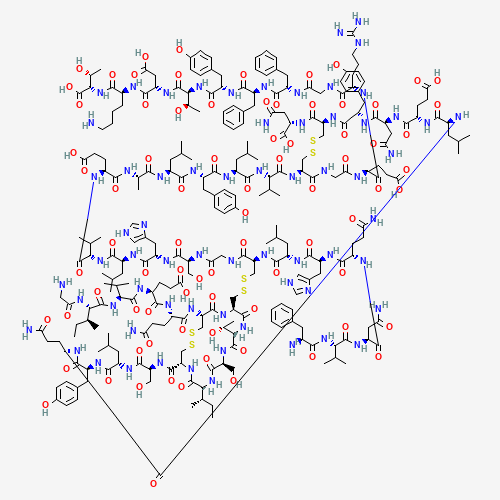| Pharmaceutical Information |
| Drug Name |
Insulin aspart |
| Drug ID |
BADD_D01160 |
| Description |
Insulin aspart is a rapid-acting form of insulin used for the treatment of hyperglycemia caused by Type 1 and Type 2 Diabetes. Insulin is typically prescribed for the management of diabetes mellitus to mimic the activity of endogenously produced human insulin, a peptide hormone produced by beta cells of the pancreas that promotes glucose metabolism. Insulin is released from the pancreas following a meal to promote the uptake of glucose from the blood into internal organs and tissues such as the liver, fat cells, and skeletal muscle. Absorption of glucose into cells allows for its transformation into glycogen or fat for storage. Insulin also inhibits hepatic glucose production, enhances protein synthesis, and inhibits lipolysis and proteolysis among many other functions.
Insulin is an important treatment in the management of Type 1 Diabetes (T1D) which is caused by an autoimmune reaction that destroys the beta cells of the pancreas, resulting in the body not being able to produce or synthesize the insulin needed to manage circulating blood sugar levels. As a result, people with T1D rely primarily on exogenous forms of insulin, such as insulin aspart, to lower glucose levels in the blood. Insulin is also used in the treatment of Type 2 Diabetes (T2D), another form of diabetes mellitus that is a slowly progressing metabolic disorder caused by a combination of genetic and lifestyle factors that promote chronically elevated blood sugar levels. Without treatment or improvement in non-pharmacological measures such as diet and exercise to lower blood glucose, high blood sugar eventually causes cellular resistance to endogenous insulin, and in the long term, damage to pancreatic islet cells. Insulin is typically prescribed later in the course of T2D, after trying several oral medications such as [DB00331], [DB01120], or [DB01261] have been tried, when sufficient damage has been caused to pancreatic cells that the body is no longer able to produce insulin on its own.
Marketed as the brand name product NovoRapid, insulin aspart begins to exert its effects within 15 minutes of subcutaneous administration, while peak levels occur 30 to 90 minutes after administration. Due to its duration of action of around 5 hours, NovoRapid is considered "bolus insulin" as it provides high levels of insulin in a short period of time to mimic the release of endogenous insulin from the pancreas after meals. Bolus insulin is often combined with once daily, long-acting "basal insulin" such as [DB01307], [DB09564], and [DB00047] to provide low concentrations of background insulin that can keep blood sugar stable between meals or overnight. Use of basal and bolus insulin together is intended to mimic the pancreas' production of endogenous insulin, with a goal of avoiding any periods of hypoglycemia.
Insulin aspart is a recombinant, biosynthetic, fast-acting insulin analogue. Compared to human insulin, it has a single amino acid substitution at position B28 where proline is replaced with aspartic acid. This substitution decreases its propensity to form hexamers and gives it a higher rate of absorption following subcutaneous administration compared to native insulin. Insulin aspart is produced in a genetically modified strain of _Saccharomyces cerevisiae_ (baker's yeast)
Without an adequate supply of insulin to promote absorption of glucose from the bloodstream, blood sugar levels can climb to dangerously high levels and can result in symptoms such as fatigue, headache, blurred vision, and increased thirst. If left untreated, the body starts to break down fat, instead of glucose, for energy which results in a build-up of ketone acids in the blood and a syndrome called ketoacidosis, which is a life-threatening medical emergency. In the long term, elevated blood sugar levels increase the risk of heart attack, stroke, and diabetic neuropathy. |
| Indications and Usage |
Insulin aspart is indicated to improve glycemic control in adults and children with diabetes mellitus. |
| Marketing Status |
approved |
| ATC Code |
A10AB05; A10AD05 |
| DrugBank ID |
DB01306
|
| KEGG ID |
D04475
|
| MeSH ID |
D061267
|
| PubChem ID |
118984445
|
| TTD Drug ID |
D0I3LE
|
| NDC Product Code |
73070-102; 73070-200; 73070-203; 0169-2201; 0169-3685; 50090-1678; 50090-4959; 0420-9010; 0169-6339; 0169-7501; 73070-100; 73070-103; 0169-2100; 0169-2200; 0169-6338; 0169-3303; 50090-2273; 70518-2823; 0169-3206; 50090-4500; 50090-4955; 52221-115; 50090-1664; 50090-4074; 70518-3236; 50090-2272; 0420-9000; 0169-2101; 0169-3696; 50090-4956 |
| UNII |
D933668QVX
|
| Synonyms |
Insulin Aspart | Aspart, Insulin | Insulin, Aspartic Acid(B28)- | Insulin B28asp | B28asp, Insulin | Insulin-Aspart | B28-Asp-Insulin | B28 Asp Insulin | NovoLog | NovoRapid |
|
| Chemical Information |
| Molecular Formula |
C256H381N65O79S6 |
| CAS Registry Number |
116094-23-6 |
| SMILES |
CCC(C)C1C(=O)NC2CSSCC(C(=O)NC(CSSCC(C(=O)NCC(=O)NC(C(=O)NC(C(=O)NC(C(=O)NC(C(=O)
NC(C(=O)NC(C(=O)NC(C(=O)NC(C(=O)NC(C(=O)NC(C(=O)NC(CSSCC(NC(=O)C(NC(=O)C(NC(=O)C
(NC(=O)C(NC(=O)C(NC(=O)C(NC(=O)C(NC(=O)C(NC2=O)CO)CC(C)C)CC3=CC=C(C=C3)O)CCC(=O)
N)CC(C)C)CCC(=O)O)CC(=O)N)CC4=CC=C(C=C4)O)C(=O)NC(CC(=O)N)C(=O)O)C(=O)NCC(=O)NC(
CCC(=O)O)C(=O)NC(CCCNC(=N)N)C(=O)NCC(=O)NC(CC5=CC=CC=C5)C(=O)NC(CC6=CC=CC=C6)C(=
O)NC(CC7=CC=C(C=C7)O)C(=O)NC(C(C)O)C(=O)NC(CC(=O)O)C(=O)NC(CCCCN)C(=O)NC(C(C)O)C
(=O)O)C(C)C)CC(C)C)CC8=CC=C(C=C8)O)CC(C)C)C)CCC(=O)O)C(C)C)CC(C)C)CC9=CNC=N9)CO)
NC(=O)C(CC(C)C)NC(=O)C(CC2=CNC=N2)NC(=O)C(CCC(=O)N)NC(=O)C(CC(=O)N)NC(=O)C(C(C)C
)NC(=O)C(CC2=CC=CC=C2)N)C(=O)NC(C(=O)NC(C(=O)N1)CO)C(C)O)NC(=O)C(CCC(=O)N)NC(=O)
C(CCC(=O)O)NC(=O)C(C(C)C)NC(=O)C(C(C)CC)NC(=O)CN |
| Chemical Structure |

|
|
| ADRs Induced by Drug |
|
|
*The priority for ADR severity classification is based on FAERS assessment, followed by the most severe level in CTCAE rating. If neither is available, it will be displayed as 'Not available'.
**The 'Not Available' level is hidden by default and can be restored by clicking on the legend twice..
|
|
|

